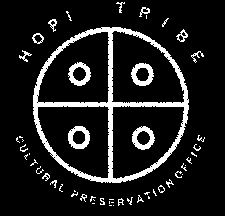



What non-Hopis have called art, katsintithu carving, basketry and pottery, Hopis consider as ceremonial and/or functional traditions, natural to everyday living. It is interesting to note that there is no Hopi word for "art." Much of what non-Hopis call art is actually sacred imagery to the Hopi people. A goal of the HCPO is to educate both the Hopi and non-Hopi public on the controversy that surrounds the commercialization of this sacred imagery. Hopi contemporary works integrate the Hopi lifeway into a variety of mediums such as painting, sculpture, and photography.
![]()
Painting
![]()
Hopi painting, traditional or contemporary, usually involves some creative freedom. The primary difference between contemporary and traditional styles is that contemporary art forms were probably learned in a formal situation, like a school, and express individual expressions for objects of beauty. Traditional art forms have been passed from Hopi to Hopi over many generations.
In the 1930s, Dorothy Dunn developed the "studio style" at the Santa Fe Indian School. The artists studied basic painting forms to learn new techniques and styles and continued to rely on subjects grounded in traditional indigenous values. The style was flat and one dimensional with simple figures and line-type movement. Subjects were semi-abstract forms in decorative water colors, depicting common events.
Hopi jeweler, painter, and potter, Charles Loloma, a staff member at the Institute of American Indian Art in Santa Fe, saw the blending of traditional points of view with contemporary expression as the goal of Indian painters in the 1960s. The Institute and Mr. Loloma have accomplished this goal and have had a monumental influence on contemporary Native American art and artists. Today Hopi painters draw from a great wealth and depth of history, visions, dreams, ancient rituals, and the knowledge and pride of being Hopi.
![]()
Sculpture
![]()
Contemporary Hopi sculptors have been greatly influenced by Charles Loloma and the Institute of American Indian Art in Santa Fe. Hopi sculptors have challenged tradition and experimented with new materials such as copper, limestone, marble, soapstone, and bronze. The sculptors of today, like other Hopi artists, have learned to overcome difficulties and disadvantages by hard work, using specialized equipment such as chisels, grinders, goggles, polishers, sanders, scrapers, and breathing masks.
![]()
Photography
![]()
The first photographs taken by Hopi people were snapshots to merely record family events. Hopi photographers today make a conscious effort to work with cultural responsibility. They must deal with conflict between obligations to Hopi people and personal artistic goals.
The goals and accomplishments of Hopi photographers vary. They range from seeking to understand and explain life to studies in personal dignity and cultural perseverance. Others invite viewers to look in the shadows and see the textures, patterns, children, buildings, and mystery.
Most recently, the HCPO and the Hopi Tribal Council granted permission to Jens Jensen, a professional photographer from Denmark, to do a photography project at Hopi. His work will be part of a traveling exhibit later this year.
Erin Younger tells us, "In Hopi photography as in Hopi Life, references and obligations overlap. Images lead into stories, stories into the past, the past into prophecies, and prophecies back to the present." Difficulties of being an independent artist and still remaining a member of the Hopi community will continue. There is always a balancing act between the Hopi community and the individual goals of the artist, whether painter, sculptor, or photographer.
The Cline Library Photo Collection at Northern Arizona University has a large collection of photos on line related to the Colorado Plateau. Included are many images of Hopi land, people, and arts and crafts. The archive can be searched in a number of ways.